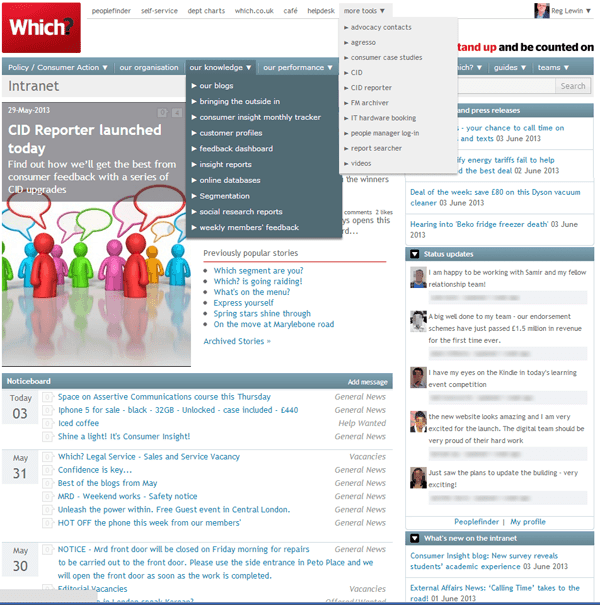Filed under: Intranet and digital workplace awards, Intranets
Open-source technologies have always been a technology option for intranets, but mainly as a component within a wider eocsystem rather than as a base platform. Security concerns, hidden costs and an inability to meet the sophisticated needs of organisations have meant enterprise intranets have tended to be built on traditional vendor-designed software.
Perhaps this is changing. Is open-source now a real player in the intranet space?
Utilising open-source technology offers a range of advantages, including:
- potentially reduced costs with no licence fees
- ability to use templates shared by others
- utilising “best of breed” features of open-source technologies (such as WordPress for blogging)
- avoiding reliance on one vendor, or being “locked-in” to a vendor’s upgrade path
- tapping in to a wide variety of development skills, plug-ins, templates and code
The winners and other leading entries in the annual Intranet Innovation Awards show that WordPress and other open-source technologies can provide an intranet platform to meet both organisational and user needs.
One of the aims of the Awards is to showcase examples of successful approaches and practices which can be applied by intranet team within their own organisations. The following sections provide real-world examples from the current crop of award winners and wider entrants:
WordPress can be used for sophisticated enterprise intranets

The homepage for Virtuos.net, an award-winning intranet based on WordPress. Screenshot courtesy of Virtuos.
In the past there has been a sneaking suspicion that WordPress just does not quite cut it as a platform for a leading intranet, but a combination of a wide pool of development skills and an array of plug-ins has helped to bridge the gap. This means that intranet teams can leverage some of its inherent advantages, such as its ease of use as the world’s most popular content management system and blogging system.
Two of our Gold Award winners in the 2013 Awards used WordPress as their base, as well as a number of the commended entries. Previous years have seen a number of open-source intranets.
Virtuous replaced a lacklustre SharePoint environment with WordPress. A variety of plug-ins such as BuddyPress supports a social environment that includes forums, gamification and other social tools, all of which have very high adoption at this computer gaming and production company. The intranet is also bi-lingual (Chinese and English). The team at Virtuous used gamification and the concepts around “levels” and badges to drive a huge uptake in formal training at the company.
The Mayo Clinic’s Nursing Department also shows that WordPress can meet sophisticated content management needs. The department’s intricate intranet meets the complex information needs of nursing staff, but also needs subject matter experts to own content pages which are critical to keep up to date. Subsequently there are over 150 sub-sites which are handled by the platform.
Reducing costs

The homepage of the DCMS intranet based on WordPress. Screenshot courtesy of DCMS.
The Department of Culture Media and Sport (DCMS) is a UK government department which uses an intranet based on WordPress. Basing a new simplified structure heavily influenced by the UK government’s digital strategy, and a strong desire to cut budgets, the new intranet not only delivers a better user experience than the previous iteration but also costs a fraction to develop and maintain. DCMS have also shared their code so other government departments can utilise the WordPress template.
2012 IIA Gold Award Winner Pleio is an open-source platform primarily used by Dutch central and local government where intranets with social features can be easily built. Partly powered by volunteers, the platform utilises the philosophy of open-source to deliver a viable intranet platform which is effectively free and is helping to reduce costs for Dutch taxpayers.
Maintaining an independent best of breed platform

The homepage of the Which? intranet. The platform is primarily based on open-source technology. Screenshot courtesy of Which?.
Which?, the largest consumer association in the UK, has an intranet which is largely based on open-source technologies including a Drupal-based content management system, blogging based on WordPress and a Lucene / Solr installation for search. New applications are built in-house in PHP. Utilising compliementary open-source technologies means that the Which? intranet is not only able to operate on a relatively low budget, but is not reliant on a platform like SharePoint where upgrades can prove very resource intensive.
It also means it is relatively easy to upgrade parts of functionality in-house when improved technologies become available, for example replacing the search technology, or to add new functionality to meet organisational need. This means the intranet is built upon a model of continuous improvement, an approach which fosters confidence among users and stakeholders.
The City of Malmo intranet is based on open-source technologies. It is built on a strong “best of breed” philosophy that deliberately avoids “vendor lock-in” and sources the strongest functionality to meet user need. Intranet manager Jesper Bylund has referred to this approach as a “third-way intranet” which avoids “mediocre tools” and having to “end up in a long-term engagement and [having] to accept the choices and the development pace the platform supplier chooses.”
There is a strong trend of continuous improvement in the City’s intranet. The ability to integrate different tools is aided by storing graphical assets on a separate server, so the integrity of the intranet design is easier to maintain.
Find out more
For more insights, the Intranet Innovation Awards annual report features 19 in-depth case studies and over 200 screenshots. This is the must-have report for intranet teams to guide their planning and represents incredible value.
And of course, if you also want to highlight the innovations on your own intranet, then the 2014 Intranet Innovation Awards opens for entries in April. You can sign up to be notified when it opens for business.
(This post was written by Steve Bynghall, who manages the Intranet Innovation Awards.)




